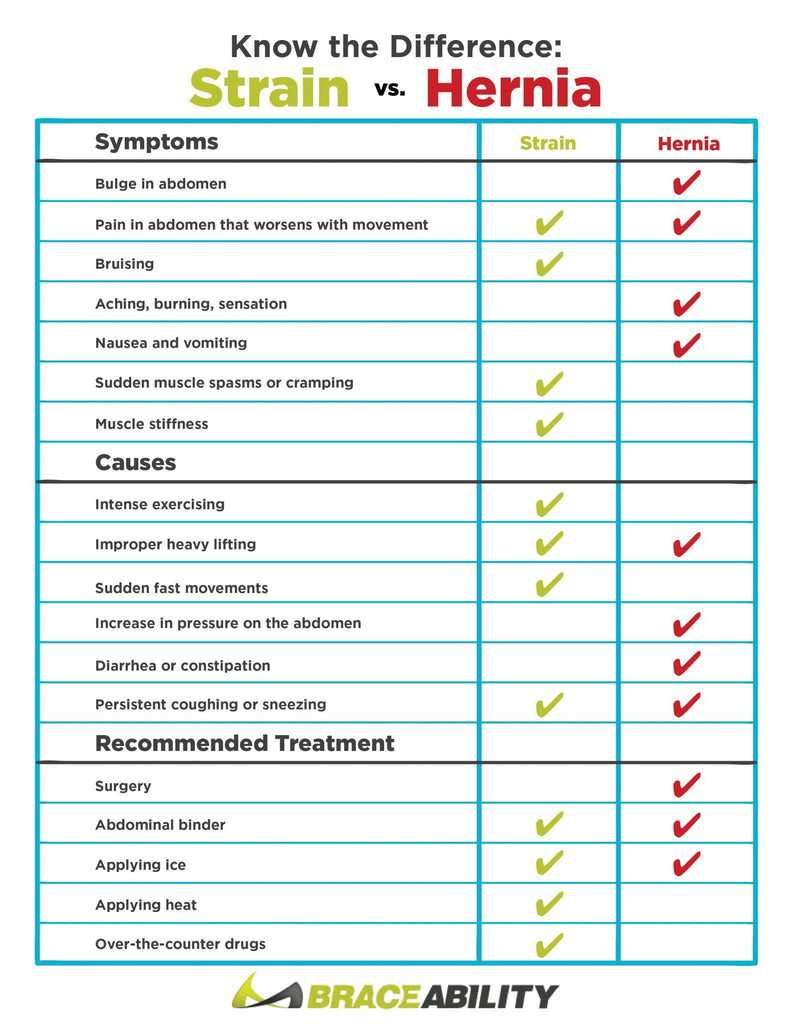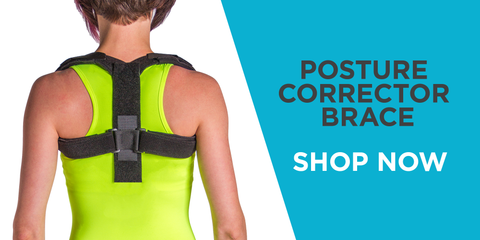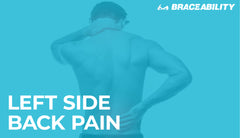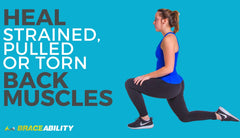Know the Difference: Abdominal Strain VS. Hernia
You are more than likely reading this because you are having some concerns about your abdominal pain and you are in limbo, thinking it may be just a strained abdominal muscle or think you may be developing an abdominal hernia. You are not alone on this issue; it can be a very tricky process in determining what is causing your extreme pain. Here are a few ways to help you in determining the difference between the strain and hernia. If at any time you are experiencing serious pain that is not subsiding, we recommend that you consult your doctor.
This chart will help you in determining your condition. Go through and see what your symptoms and causes are to give you a better idea of what condition you may have, and what treatments you may want to consider. The rest of this post will provide additional information on your condition.

Abdominal Strain
Pain in the abdomen area could mean many possible things. Abdominal strains, or pulled abdominal muscle, will generally happen during intense or excessive exercising. For that reason, strains are very common in athletes or highly active individuals. Strained muscles could also happen when you make sudden, fast movements like coughing, sneezing or lifting something heavy. You went too hard, and put excess strain on certain areas your body and tore or pulled a muscle.
What actually happens when you strain your muscles?
They overstretch to the point where they forcefully contracted, (that should make you cringe just thinking about it). When the muscles are contracted like that, it makes them that much more vulnerable and susceptible to injury. You usually will not be able to visually see the abdominal strain injury from the outside. Although, if it is a serious enough strain there may be some bruising around the affected area.
How do I know if I pulled a stomach muscle?
Here are some abdominal wall tear symptoms you may be experiencing if you are suffering from a strained or pulled an abdominal muscle:
- Pain in abdomen area that worsens when you move
- Sudden muscle spasms or cramping
- Bruising
- Muscle weakness or stiffness
- Difficulty walking, bending forward or sideways, or standing straight
These muscle strains can be mild, moderate or severe. The pain will decrease with time as your injured muscle heals. Depending on the injury, it could be a few days or may last as long as a few months.
How can I treat my abdominal strain?
Here are a few things you can do that will help to ease the pain of a pulled stomach muscle:
-
Rest:
This seems like common sense but is commonly ignored by competitive athletes wanting to get back in the game. When you don’t give your body time to rest, it makes the condition worse, setting your recovery back even further. Your abdominal muscles are used for almost all your movements, sitting, standing up, twisting, etc. This makes it very difficult to rest your abdominal muscle. If you are experiencing some pain and discomfort during these movements, we recommend you check out our binders and wraps for abdominal muscle pain and strain. -
Applying Ice & Heat:
Applying ice and heat will help to relieve some pain and tenderness you might be experiencing. -
Over-the-Counter Drugs:
To help ease the pain and reduce inflammation, you can take over-the-counter anti-inflammatory medications, such as Ibuprofen. -
Compression:
Using compression will help to apply pressure and help the affected area. If you are looking for something that will give you constant compression, hands-free we have an abdominal brace that helps especially with an abdominal strain.

Is there a way to prevent abdominal strains?
Not all muscle strains can be avoided, but you may be able to reduce the risk of an abdominal muscle strain from occurring again with these preventative options:
-
Warm up:
Let’s be honest, everyone thinks that you can just jump right into exercising without warming up. It is recommended that you spend 10- 20 minutes before you start your workout to get your muscles ready. -
Recovery:
You need to give your muscles time to recover. Make sure you are doing a cool down after an intense workout. If you participate in strenuous activities every day, make sure you are resting the muscles and not overworking affected areas day after day. -
Maintaining good muscle strength:
If your muscles are strong, it is less likely they will tear or become injured. -
Diet:
Eat healthily and drink lots of fluids. Maintaining a healthy, balanced diet helps to strengthen bones and muscles. -
Stretch:
You should stretch before and after a workout. We know, it's really easy to skip, but it is so important to make an effort to stretch. -
Practice good posture:
Maintain good posture when sitting or standing, and avoid sitting in one position for a long period of time which puts extra strain on your abdominal muscles. If you are looking for a way to improve your posture, check out our adjustable posture brace that can help to pull your shoulders back into a proper posture position. -
Practice proper lifting techniques:
When you lift heavy objects, properly bend at your knees and lift with your legs, with the weight close to your body. -
Understand your body’s limitations:
Avoid overworking your muscles, you know when your body needs to stop, so listen to it. If you do not currently exercise, start slowly and ease into more rigorous activity.
If your strain is sharp and you are experiencing extreme pain and you are not getting relief from any remedies, you need to consult a doctor. They will give you an examination and more than likely an ultrasound, which will help to see if there is just a tear or if there is actually a hernia present.
Abdominal Hernias
An abdominal hernia occurs when internal organs (like your intestine) or surrounding connective tissue pushes through a weakened area in your abdominal muscles. The weakened area may be there from birth, or it may develop later. If there is repetitive stress or pressure, it will cause the organ or tissue to push through the weakened opening. Really anything that causes an increase in pressure can cause a hernia, the improper lifting of heavy objects, repeated coughing or sneezing, diarrhea or constipation. Did you know: There are over 350,000 abdominal hernia repair surgeries performed each year. You are not alone if you are considering getting abdominal hernia surgery.
How do I know if I have an abdominal hernia?
Some symptoms you may be experiencing if you have a hernia:- A distinct bulge in your abdominal area
- Aching or burning sensitivity at the affected area
- Pain or discomfort, especially during activities such as lifting
- Not all hernias cause pain, but they could become more painful the longer they go untreated
- Nausea, vomiting: hernias become suffocated when blood flow is cut off to the intestine that is pushing through your abdominal wall. This may cause nausea or vomiting, but these symptoms are not caused by a pulled muscle
What can I do to treat my abdominal hernia?
The following are treatments for an abdominal hernia:- In general, the most typical treatment for an abdominal hernia is hernia-repair surgery, in which the doctor surgically repairs the abdominal wall. During this surgery, the organ or tissue is pushed back into its place and tied off or removed. Depending on the size of a hernia, the edges of the healthy muscle will be sewn back together to repair the weak section. In larger hernias, they may repair a hernia with mesh patch reinforcement.
- After an abdominal hernia surgery, you may want to consider an abdominal binder. BraceAbility offers several hernia belts that will help protect your incision site, reduce swelling, and help quicken your recovery process.
- Most people are able to go home the day of their procedure and it takes about 3 weeks to recover. After these 3 weeks, you will be able to participate in some light activity, but it is advised to wait an additional 3 weeks before any high-intensity exercises.
- Compressing an ice pack against an abdominal hernia is a great treatment option; this can help ease the pain and swelling that is caused by a hernia. You should avoid applying heat or pressure to the affected area. Heat can cause muscle spasm and make the area swell, which worsens the condition.
Is there a way to prevent abdominal hernias?
There isn't a lot you can do to prevent a hernia from occurring, but there are a few proactive things that you can try to help avoid surgery:
- Wearing an abdominal hernia binder or belt will help because it puts pressure on the weak area of the abdomen wall, preventing the organ or tissue from bulging out.
- Avoid activities that put excess strain on the abdominal area; such as continuous coughing or sneezing and heavy lifting. These activities can actually cause your hernia to increase in size.
- Eat smaller, more frequent meals during the day including fresh vegetables, fruits, and whole grains.
- Avoid consuming alcohol as it can cause gastrointestinal pain, bloating and inflammation.
- If you are exercising, make sure you are not doing it on a full stomach.
- Try not to lie down or bend over soon after eating.
We hope this article helps in determining if your abdominal pain is a strain or a hernia. Again, it is advised to consult your doctor if you notice symptoms of an abdominal hernia.






